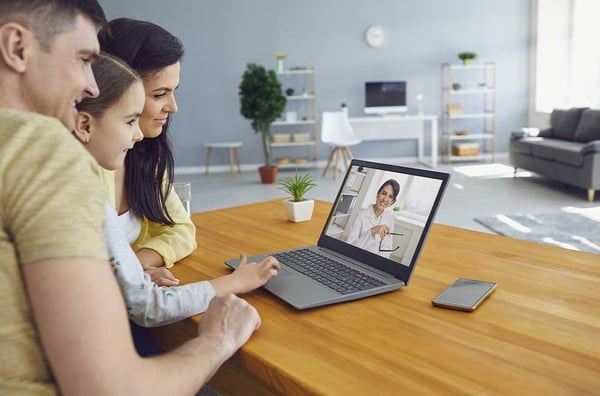Pediatric telehealth can be a very beneficial tool for children, one that helps connect the child and their family with different types of healthcare services. Telehealth technologies help pediatric patients manage their condition and avoid poor outcomes by providing tools for virtual visits, medication management, symptom surveys, and biometric monitoring. For the family or caregiver, telehealth provides necessary education and support.
Telehealth for children offers many benefits—it bridges geographical and logistical barriers, while also improving outcomes and reducing total cost of care.
The Pros of Telehealth for Kids
- Flexibility and increased access - with telehealth, the patient and their family can access their provider when they need to. The barriers of travel time and location are removed. Navigating pediatric care can be a challenge for many families—telehealth enables the patient and their family to access their provider at a time when it works for them. The parent or caregiver does not have to arrange (and pay) for transportation or take off work, and often, the child does not have to be pulled out of school for an in-person visit. Telehealth enables patients to access specialists that they otherwise would be unable to due to geographic limitations or other barriers.
- Comfort - for most children, home is a place of comfort and support. With telehealth, kids can receive care at home where they are most comfortable, as opposed to an unfamiliar clinic or office.
- Direct support - telehealth facilitates direct support right when the patient needs it. For example, when a symptom is exacerbating, the child can get in contact with their provider. For behavioral health patients, for example those with eating disorders, telehealth can be used during stressful times such as meal-time. Through pediatric telemedicine, or virtual visits, the child and their family can contact their provider directly, and get support on demand, as needed.
Improved Convenience with Pediatric Telemedicine
A recent study concluded that pediatric telehealth resulted in improved patient and family satisfaction, cost saving, reduced emergency room visits, and less time off work for parents. With pediatrician visits or a sick child being the most common reason why parents miss work, this is a huge benefit.
Another study found that when asked about the efficacy of telehealth in a pediatric healthcare clinic, 100% of parents responded that telehealth visits were more convenient and less of a disruption to the daily lives of themselves and their child(ren).

Applications for Children’s Telehealth
There are many pediatric conditions that can be effectively managed through telehealth technologies. For behavioral health needs, children with medical complexity, or even for acute needs and routine exams, telehealth can play a role.
When a child needs to access their doctor for on-demand sick visits or acute needs, for example, a rash, cold, minor illness, pink eye, acne, constipation, minor trauma (cuts, abrasions), or minor GI issues, telehealth is a fantastic tool and one that is convenient and accessible.
In the United States 19.8% of children aged 0-17 have special healthcare needs—”those who have or are at increased risk for chronic physical, developmental, behavioral, or emotional conditions and who also require health and related services of a type or amount beyond that required by children generally”. For these children, telehealth is a fantastic resource as it facilitates continuous, high quality care. Currently, only 43% of children with special healthcare needs receive the ongoing, coordinated support they need. Telehealth for kids helps bridge this gap.
Today, pediatrics patients and their families and caregivers are using telehealth to manage a range of healthcare needs including:
- Asthma
- Diabetes
- Genetic conditions
- Behavioral health
- Autism support
- Speech therapy
- Obesity treatments
- Neonatal care
Pediatric Telehealth Doesn’t Replace the Pediatrician
Pediatric telehealth can augment in-person specialist and pediatrician visits, creating opportunities for more convenient, cost effective healthcare. Pediatricians and pediatric specialists should consider incorporating telehealth services into their practice to increase access, improve their patient’s outcomes, and increase patient and family satisfaction.
